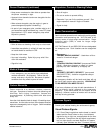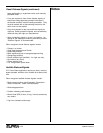
— 12 © 2006 Skier’s Choice, Inc.
Grounding (continued)
Basic Guidelines
• Inspect damage to hull, propulsion and steering
systems.
• Check for leaks. If water is coming in, stopping the flow
takes priority over getting free.
• Determine water depth all around the boat and type of
bottom (sand, mud, rocks, etc.). This will help you
decide which way to move the boat.
• Determine if tide, wind or current will drive the boat harder
aground or will help free it.
Leaks
• Immediately switch on bilge pumps.
• Assign crew to operate manual pumps, if needed.
• If boat is taking on water, have someone take the helm
while you manage damage control.
• Slow or stop to minimize inflow. However, if you can
keep a hole above water by maintaining speed, do so.
• If possible, patch the outside with whatever material is
available.
Towing
PERSONAL INJURY HAZARD
Towing or being towed stresses the boats, hardware
and lines. Failure of any part can seriously injure
people or damage the boat.
A recreational boat towing another is usually a last resort
because of possible damage to one or both boats. The
Coast Guard or a private salvage company is better
equipped. A recreational boat may assist by standing by,
and possibly keeping the disabled boat’s bow at a proper
angle until help arrives. Only when conditions are ideal—
that is, waters are calm, disabled boat is small, and one
or both skippers know correct technique—should a
recreational boat tow another.
Towing Vessel
• Be sure your boat will not run aground too.
• Because you are maneuverable and the grounded boat
is not, you should pass the towline to the grounded
boat.
Towing Vessel (continued)
• Use double-braided or braid-on-braid line. Never use
three-strand twisted nylon; it has too much elasticity
and can snap back dangerously.
• Fasten the towline as far forward as possible on the
upwind or up-current side of the towing boat. Fastening
it to the stern will restrict maneuverability of the towing
boat.
• If possible, use a bridle.
• Move slowly to prevent sudden strain on slack line.
• Be ready to cast loose or cut the line if the towing
situation becomes hazardous.
Vessel Being Towed
• Attach the towline to the bow eye, forward bitt or cleats
if the fitting can take the load.
• If the boat has eyebolts in the transom for pulling skiers,
a towline may be attached to a small bridle hooked to
both eyebolts.
• If it is necessary to be towed after being freed, keep
someone at the wheel to steer.
Both Vessels
• If you attach the towline to a fitting, be sure the fitting is
fastened with a through bolt and is reinforced on the
underside.
• Creating a bridle with a line around the hull or
superstructure will distribute the load over a wide area;
pad pressure points. This technique can be used on
both the towing and towed boat.
• Keep lines clear of propellers on both boats.
• Keep hands and feet clear of the other boat.
• Never hold a towline after it is pulled taut.
Person Overboard
• Immediately sound an alarm and keep pointing to the
person overboard.
• Throw a life preserver even if the person is wearing a
PFD. It will serve as a marker.
• Immediately stop or slow the boat, then circle toward
the victim.


















